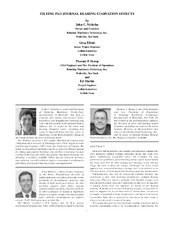| dc.description.abstract | Improved turbomachinery aerodynamic performance requirements have increased journal bearing operating speeds and loads well above traditionally acceptable values. For example, for high performance gearboxes, pinion bearing surface speed requirements are often over 325 f/s with bearing unit loading in the 500 psi range. In order to meet the design challenges for these severe applications, evaporated bearing housings have been utilized as an effective means of reduction journal bearing operating temperatures. Unfortunately, the use of evacuated housing designs has introduced a new and troubling phenomena - journal bearing starvation. This was never a problem with flooded designs with pressurized housings since any additional oil that may be required is simply drawn from the captured oil inside of the bearing housing. With the new evacuated housing designs, all required oil must be supplied by the oil inlet orifices. Often times, the amount of supply oil required to keep all pads from starving is well beyond reasonable. Thus, due to practicality, starvation in some form is allowed in almost all evacuated designs. This paper discusses evacuated journal bearing starvation and its possible detrimental effects on rotordynamics. Specifically, the effect of starvation on journal bearing stiffness and damping is investigated. A case history is presented showing the effect of increasing oil flow on the location and amplification of a gearbox pinion critical speed during new zero load mechanical testing. As flow increased and the bearing became less starved, the location of the critical increased while the amplification decreased indicating a strong dependency of bearing stiffness and damping on oil flow. Concurrently, a similar but smaller bearing was tested under zero load starvation conditions. Essentially no effect on stiffness and damping was evident. From these results, the authors conclude that although increasing the oil flow solved the problem, starvation in itself was not the cause. | en |


